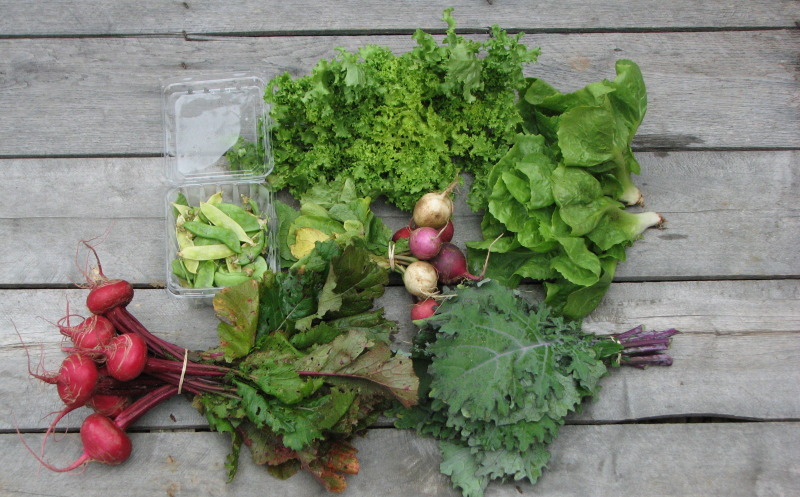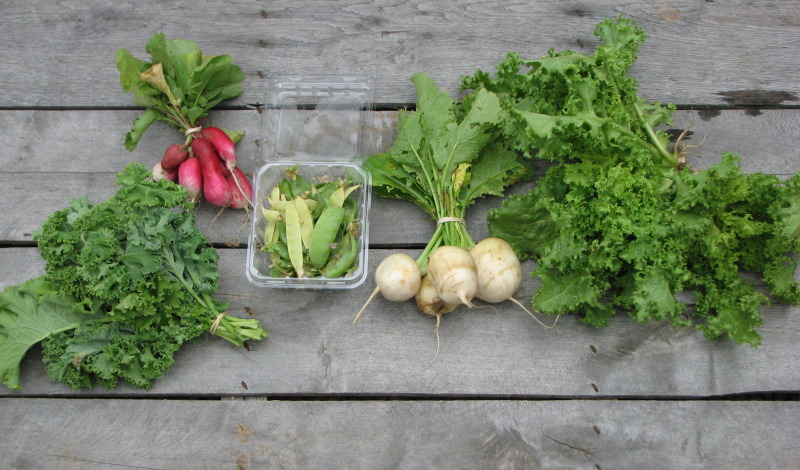2015 Spring Share #2
CSA Share Notes:
This week we are excited to bring you several new items from the garden. We hope some of these are new to you and that you’re eager to test out some new veggies in your kitchen. Look forward to lots more from the Red Moon Farm CSA as the weather warms and (hopefully) dries out.
- Turnip—Small shares received the Japanese salad turnip called Hakurei and Large shares received Scarlet Queen. That’s right: those are not beets, they’re bright red turnips! Both varieties are interesting and unique. Are you familiar with preparing turnip? We think that the Hakurei turnip is best eaten raw. Read up on the Hakurei turnip here. And for those who received the scarlet queen, try out this roasted veggie salad, so hearty it can be a vegetarian main course: turnip and grain salad. In your bunch of turnips you’ll likely find that the roots are crisp and fantastic but the greens are not holding up well to the wet garden conditions.
- Radish—Small shares received French Breakfast radishes, and Large shares received Easter Egg radishes. The conditions in which the plants are grown can greatly change the flavor. Two weeks ago your radishes were quite spicy and this week, they are incredibly mild due to just slightly different conditions. They would be great eaten raw in this winter root salad recipe with your fresh crisp turnips and a few extra root veggies you have on hand.
- Endive—Frisee Endive is often sold as lettuce, but it’s actually more closely related to the daisy than it is to any lettuce varieties. This salad green is a high dollar crop with a good, hearty flavor that would be perfect in a salad with lots of diverse flavors: strawberries and blue cheese, Pecorino and apples, or maybe olives and artichokes. If it’s a bit strong for you, mix it at a ratio of about 1:2 with very mild salad greens like bibb lettuce or baby spinach.
- Escarole—The large shares received a nice full head of Batavian escarole. This is the salad green that looks similar to romaine, but again, this is not exactly a lettuce but a crop just slightly different. Enjoy the great flavor. Escarole, a salad green that has a lot of meat to it. There are plenty of other interesting and high-end salad greens we have in the works for you, and some of you are probably new to trying them out. Here’s a helpful image detailing some of the many chef-coveted salad vegetables and a cool write-up on the background and differences in these varieties you’ll be receiving.
- Kale or Collard—Large shares received red Russian kale and/or collard greens, and the small shares received curly kale called Winter Bor. These greens are all very closely related, both genetically and in flavor, and can often work interchangeably in recipes. Either cook them up southern style with a little bacon and garlic, or try the Massaged Kale Salad or the Rainbow Kale Salad.
- Snow Peas—We are happy our snow peas are ready earlier than expected! This week everyone receives a full pint of bi-color peas, both green and yellow varieties. You do not have to shell snow peas. They are delicious when young and flat, and when fully mature with large peas inside. These would be an excellent addition to the salad suggestions above or tossed a stir fry, or baked into a fritatta. We hope you love them!
Veggie Storage tips:
The greens will all last longest stored in the refrigerator, sealed up to retain their moisture. The radish roots and turnip roots should be severed from their tops to keep them firm and crisp. If you’d like to eat the tops, they can be stored sealed in a bag in the fridge. Everything will need a gentle washing before cooking, but leave the dirt on until you’re ready to use them. As a general rule, wait to wash any veggies until you’re ready to use them to help retain nutrients and prevent spoilage from excess moisture.
We’d love to hear stories and recipes of your culinary adventures this week. Send us a note or post a comment of how you’ve used your CSA share!
Your farmers,
Jess & Justin
Large Share

Large share from top to bottom: Frisee Endive, Batavian Escarole, bi-color snow peas, Easter egg radishes, Scarlet Queen turnips, and Red Russian Kale (or collard, not pictured).
Small Share

Small share from left to right: Winter Bor kale, French Breakfast radishes, snow peas, Hakurei turnips, Frisee endive.